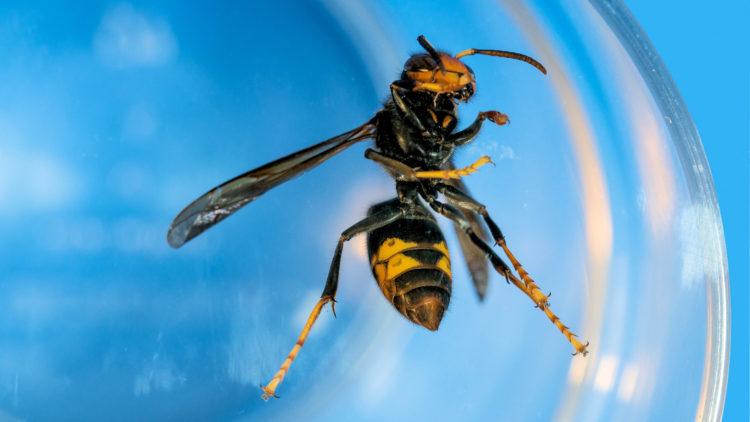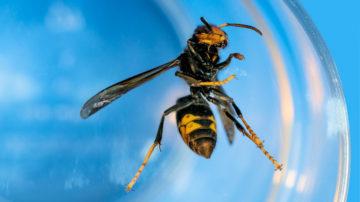On Monday, Guernsey’s Asian Hornet Team responded quickly to a confirmed sighting of Asian hornets and subsequently discovered and removed a primary nest containing 100 hornets.
The nest was located in a bird box in a residential garden off Rue de L’Ecole, Vale. The homeowner became aware of the nest inside the bird box after a family member was stung whilst gardening close to the box after it had fallen off the tree. They submitted photographs to the Asian Hornet Team who carried out a risk assessment the next day and returned at dusk to remove the bird box when all of the flying worker hornets were inside.
On later examination, the nest was found to be the size of a grapefruit (4 inches/10 centimetres in diameter). Along with the large queen, there were 17 worker hornets attending to a further 82 eggs, larvae and pupae. The total size of the colony equates to 100 hornets.
This discovery is significant as it is the first sighting of an Asian hornet since 10th June 2021 when a queen hornet was captured from a flat in St Peter Port. This was around the same time that three queens were also trapped from the Vale. It is likely that this latest nest developed from a queen that arrived in the island in early June.
- The first recorded sighting of an Asian hornet in Guernsey was in March 2017. Over the last two years the number of Asian hornet nests found in Guernsey has been reduced from 8 in 2018, to 2 in 2019 and none in 2020.
- A large nest can hold as many as 5,000 hornets, which presents a risk to the public, and will cause significant harm to our native insect populations, such as bees.
- While an individual Asian hornet sting is not considered to be much worse that than of a bee or wasp, hornets are very defensive and will aggressively protect their nest if it is disturbed.
 Francis Russell – Project Coordinator (Asian Hornet Strategy) says: “This was the second primary nest found on the island this year and it was surprising how small it was considering the queen probably started building it in early June. The fact that the bird box fell out of the tree clearly confused the hornets as the combs were still on their side rather than in the normal horizontal alignment.
Francis Russell – Project Coordinator (Asian Hornet Strategy) says: “This was the second primary nest found on the island this year and it was surprising how small it was considering the queen probably started building it in early June. The fact that the bird box fell out of the tree clearly confused the hornets as the combs were still on their side rather than in the normal horizontal alignment.
“It was fortunate the nest was found and reported to us urgently as we know that when confined in a small space the workers and the queen will leave the primary nest to construct a larger secondary nest – typically in the treetops nearby. We have placed a trap in the garden just in case we missed any of the workers and to rule out
the possibility that there isn’t another nest nearby”.
This discovery highlights the important role played by the public in helping to control this invasive species. The aim of the Asian Hornet Strategy is to keep the populations of Asian hornet as low as possible, to protect public health and the island’s biodiversity. Suspected sightings should be reported to asianhornet@gov.gg or telephone 01481 224567 or 07839 197082.
- The first recorded sighting of an Asian hornet in Guernsey was in March 2017. Over the last two years the number of Asian hornet nests found in Guernsey has been reduced from 8 in 2018, to 2 in 2019 and none in 2020.
- A large nest can hold as many as 5,000 hornets, which presents a risk to the public, and will cause significant harm to our native insect populations, such as bees.
- The Asian Hornet Strategy is an ongoing strategy endorsed by the Committee for the Environment & Infrastructure in 2018 and being implemented by Agriculture, Countryside & Land Management Services (ACLMS).
- While an individual Asian hornet sting is not considered to be much worse that than of a bee or wasp, hornets are very defensive and will aggressively protect their nest if it is disturbed.












